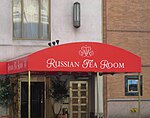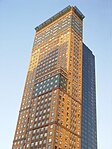The Briarcliffe

The Briarcliffe is a 13-story, 35-unit residence at 171 West 57th Street, at the northeastern corner with Seventh Avenue, in Midtown Manhattan, New York City. Located just north of Carnegie Hall, the property was built as a hotel in 1922, designed by architects Warren and Wetmore, and converted to its current purpose as condominiums in 1999. The Briarcliffe is part of Billionaires' Row and shares a city block with the Alwyn Court to the north and 165 West 57th Street, One57, the Nippon Club Tower, the Calvary Baptist Church, and 111 West 57th Street to the east. In 1998, the owner of the building hired architect Richard Rice to ready the deteriorating property to be placed on the market. The building's murals had been damaged by water, and Rice was prepared to restore them; however, the following year, the building was converted to a condominium, and the murals were destroyed in the reconstruction work.
Excerpt from the Wikipedia article The Briarcliffe (License: CC BY-SA 3.0, Authors, Images).The Briarcliffe
West 57th Street, New York Manhattan
Geographical coordinates (GPS) Address Nearby Places Show on map
Geographical coordinates (GPS)
| Latitude | Longitude |
|---|---|
| N 40.7655614 ° | E -73.9795838 ° |
Address
West 57th Street 171
10019 New York, Manhattan
New York, United States
Open on Google Maps










